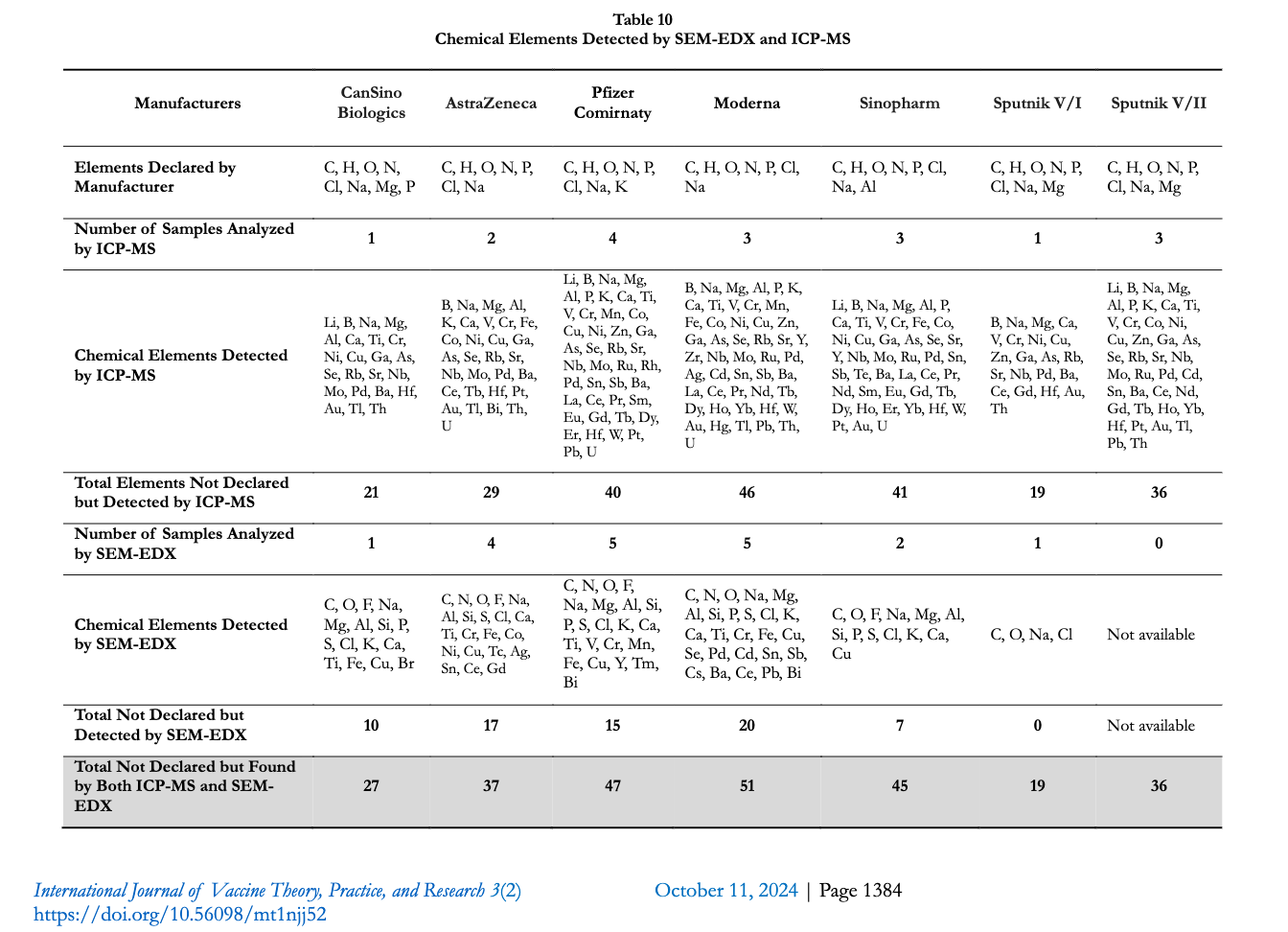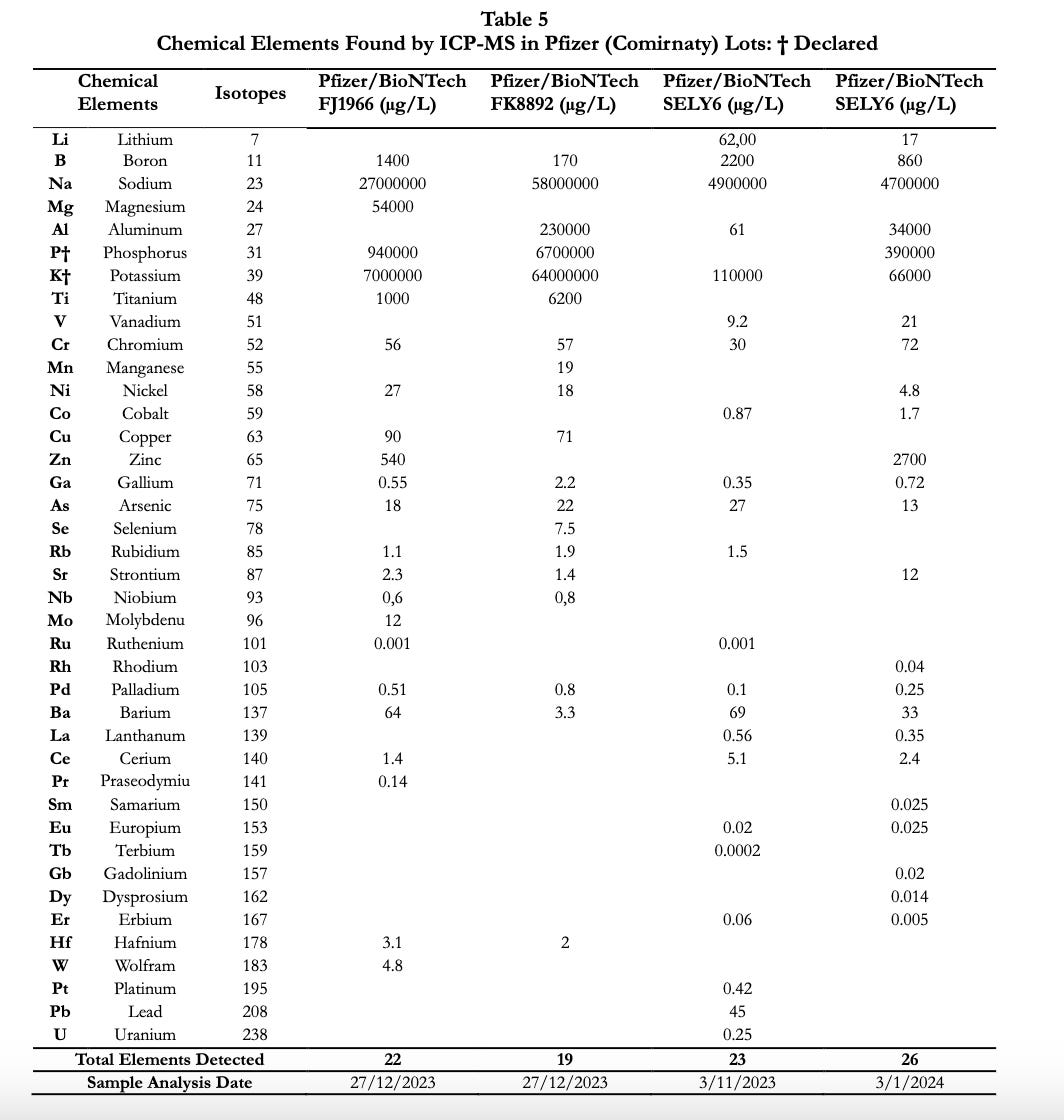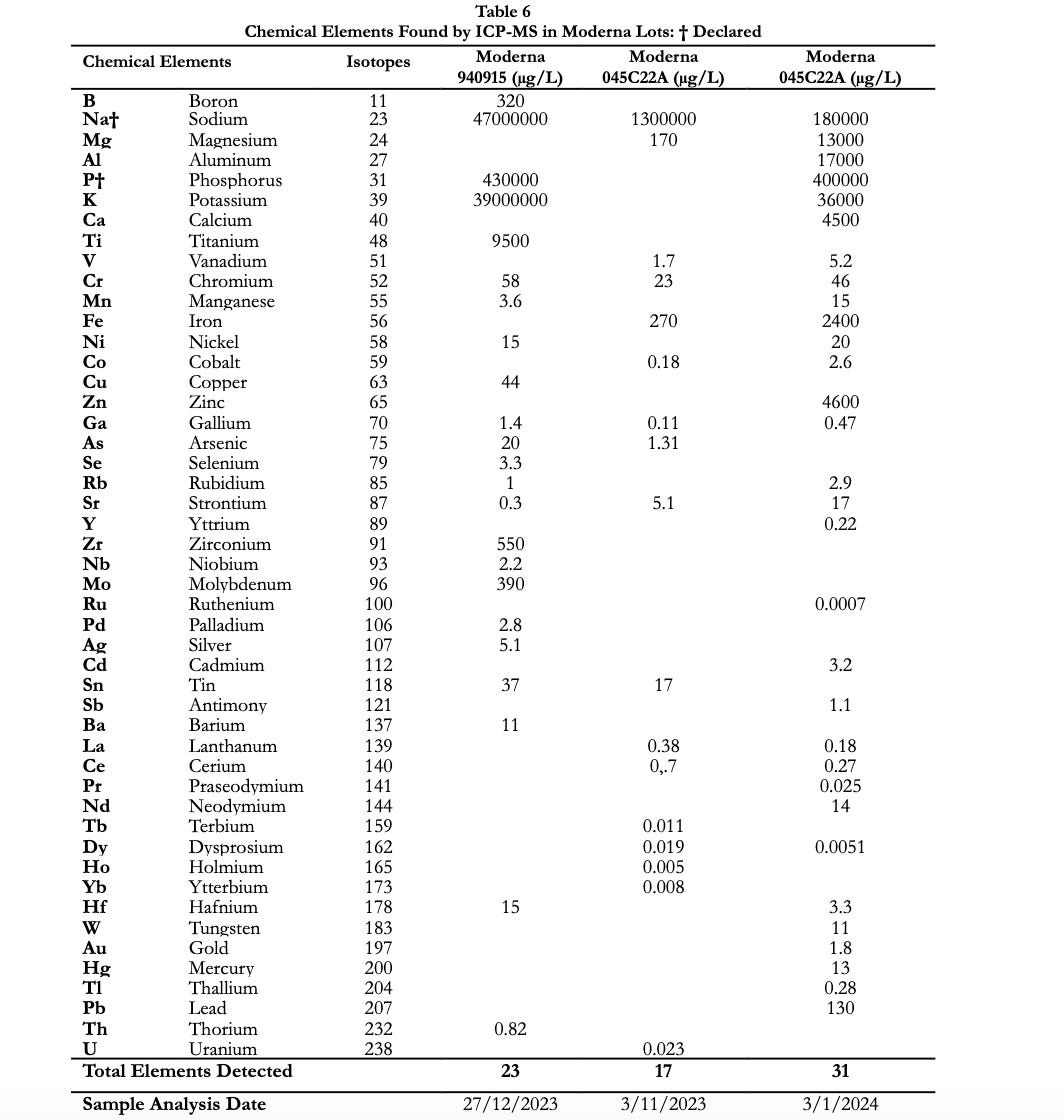|
Study Finds At Least 55 Chemical Elements, Including Toxic Heavy Metals in COVID Shots
The never-disclosed chemical elements included 11 cytotoxic lanthanides and 11 heavy metals, such as arsenic, lead, aluminum, and mercury.
As if modified RNA, spike proteins, and lipid nanoparticles weren’t bad enough, a new study published in the International Journal of Vaccine Theory, Practice, and Research found at least 55 chemicals in COVID-19 vaccines from Moderna, Pfizer, and others that were not publically disclosed by manufacturers. These chemical elements include a range of heavy metals, all of which are potentially harmful to humans.
Using a highly precise analytical technique known as Inductively Coupled Plasma Mass Spectrometry (ICP-MS), researchers set out to determine whether COVID-19 vaccines contain undeclared elements beyond what the manufacturers officially disclosed.
The researchers analyzed 17 different lots of six brands of COVID-19 vaccines, including Pfizer-BioNTech, Moderna, AstraZeneca, and Johnson & Johnson. Among the undeclared elements, all groups on the Periodic Table were represented except for the noble gases.
Researchers detected all 11 of the most concerning heavy metals. Chromium was found in 100% of the samples; arsenic in 82%; nickel in 59%; cobalt and copper in 47%; tin in 35%; cadmium, lead, and manganese in 18%; and mercury in 6% of samples.
Researchers found varying levels of boron, calcium, titanium, aluminum, arsenic, nickel, chromium, copper, gallium, strontium, niobium, molybdenum, barium, and hafnium in all brands tested.
Heavy metals are a group of metallic elements with relatively high densities and are toxic or poisonous even at low concentrations. They are naturally occurring elements but can become hazardous when concentrated in the environment or the human body. Although some, like iron and zinc, are essential for biological functions in small amounts, excessive exposure to others, such as lead and mercury, can lead to neurotoxicity, kidney damage, immune system disruption, and other serious health effects.
The International Agency for Research on Cancer has designated arsenic, cadmium, chromium, and nickel as Group 1 carcinogens, meaning they are carcinogenic to humans.
(Most of the studies on heavy metals involve ingestion, inhalation, or contact with the skin. Imagine how bad it is to inject them directly into the body.)
The researchers also detected 11 of the 15 cytotoxic lanthanides used in electronic devices and optogenetics. Lanthanides, a group of 15 metallic elements, can be toxic primarily because they interfere with biological processes. When introduced into the body, these metals can accumulate in tissues, particularly the liver and bones, where they disrupt cellular functions and enzyme activity, contributing to inflammatory responses and immune system dysfunction.
Toxicity often results from their chemical reactivity, leading to oxidative stress and DNA damage, which can cause carcinogenic mutations. While most lanthanides are considered low in toxicity in small amounts, their cytotoxic effects can manifest in inflammation, immune system dysfunction, chronic diseases, and cancer with prolonged exposure through repeated vaccine doses.
More alarmingly, the study found no evidence that these undeclared elements were due to accidental contamination. The researchers, comprised of biologists, a physician, and a biotechnologist, believe the inclusion of these materials points to a global technological experiment involving nanotechnology.
Although the researchers did test samples of Johnson & Johnson and AstraZeneca, Moderna and Pfizer are the only two currently licensed for use in the United States, so this article focuses on these two injections. Moreover, the greatest number of undeclared chemical elements were detected in Pfizer, Moderna, and AstraZeneca.
The image below from the study shows what elements were declared by each vaccine maker and which elements were detected and not disclosed.
Findings in Pfizer Samples
Researchers analyzed three lots of Pfizer’s COVID-19 vaccine. In lot FJ1966, 22 elements were detected, of which 19 were undeclared. In lot FK8892, 19 elements were detected, of which 16 were undeclared. Lot SELY6 was analyzed on two dates. In November 2023, 23 chemical elements were detected, of which 21 elements were undeclared. In January 2024, 26 chemical elements were detected, of which 23 elements were undeclared.
In the Pfizer samples, researchers detected lead, a well-established neurotoxin that can cause serious damage to the nervous system, even in trace amounts. Long-term exposure to lead has been linked to developmental delays, cognitive dysfunction, and irreversible damage to organs. The Pfizer samples also contained antimony, a toxic metalloid associated with respiratory and cardiovascular issues when absorbed into the body.
This means that there are toxic ingredients that Pfizer never disclosed to the U.S. Food and Drug Administration (FDA), that the FDA never tested for, and that, by extension, were never disclosed to vaccine recipients.
Here’s an image from the study showing the elements identified in each Pfizer lot and what the company failed to disclose:
Here are the ingredients listed by the FDA in its fact sheet for recipients of Pfizer’s COVID-19 vaccine:
Although the disclosed ingredients are concerning in and of themselves, why are injections containing heavy metals and cytotoxic elements being recommended to anyone, let alone children and infants? Where are our U.S. health agencies? Why weren’t tests performed by the agencies funded by our tax dollars and tasked with ensuring these products are safe?
Findings in Moderna Samples
Researchers examined multiple vaccine lots of Moderna’s COVID-19 injection and identified several undeclared heavy metals. For example, in Moderna lot 048A21A, nickel and aluminum were detected. These metals are known for their toxicological effects. Nickel is a carcinogen and can provoke allergic reactions and induce cancer with repeated exposure, while aluminum is linked to neurotoxicity and the risk of Alzheimer's disease when it accumulates in the brain.
Long-term exposure to metals like antimony, chromium, and cobalt can also lead to chronic health conditions, including respiratory issues, cardiovascular disease, and, in some cases, cancer. While the quantities detected in the vaccines may be small, repeated exposure through multiple doses could accumulate in body tissues, leading to toxic overload.
Aluminum is a controversial adjuvant pharmaceutical companies use to enhance the immune response. It is hazardous, neurotoxic in large doses, and can accumulate in brain tissue. Aluminum is also found in pediatric vaccinations and is primarily excreted by the kidneys.
Why is this a problem?
COVID-19 vaccines are authorized for infants as young as six months of age. Young children do not have fully developed kidney function capable of removing aluminum from their bodies—and they are exposed to aluminum not only from the COVID shot but also from the barrage of pediatric vaccines.
Other lots, such as 030B21A and 025L20A, also contained chromium and arsenic, which are associated with immune dysfunction and carcinogenesis.
Here are the ingredients listed by the FDA in its fact sheet for recipients of Moderna’s COVID-19 vaccine:
Study Suggests “Worldwide Technological Experimentation”
According to the study, sodium and chromium were found in 100% of all samples tested, and other undeclared elements were also found in a majority of samples. For example, boron and gallium were found in 88% of samples, while vanadium, cerium, platinum, and barium were present in 71 to 76% of samples.
“Given the diversity and notable presence in all brands, along with the peculiar characteristics of the elements found, it is extremely unlikely, in our judgment, that the findings reported in this paper are due to any fortuitous events such as contamination or accidental adulteration,” the authors wrote.
“We do not believe that accidents owed to chance could occur so consistently and pervasively across the various brands of vaccines that we studied. Whereas the appearance of the daunting diversity of undeclared chemical elements remains strange, the clues seem to be pointing to some kind of worldwide technological experimentation,” they added.
Because the lanthanides found in the samples are known to be extremely cytotoxic, their presence in the samples and their significant quantity—across a whole array of vaccine studies—are “suggestive of some kind of nanotechnological experimentation.”
The study's authors also raised questions about Pfizer’s vaccine and its suggested temperature for storing and transporting its product.
A cold chain of custody refers to the process of storing and transporting temperature-sensitive products, such as vaccines, under strict temperature-controlled conditions to ensure their effectiveness and safety. For vaccines, maintaining a specific temperature range—often very cold, like -80°C for some COVID-19 vaccines—prevents degradation of the active ingredients, particularly fragile components like mRNA or lipid nanoparticles. A break in the cold chain can cause the vaccine to lose potency or become ineffective.
In the context of the Pfizer COVID-19 vaccine, the cold chain of custody was initially set at ultra-low temperatures (-80°C), raising questions about why such extreme cold was needed, especially given the stability of the materials at higher but still cold temperatures (-20°C). The researchers speculate that it might have been to prevent the formation of self-assembling structures or to preserve sensitive genetic material in the vaccine formulation.
“So, we wonder why Pfizer initially urged a cold chain of custody at no warmer than 80°C below zero. Of course, subjecting genetic material encapsulated in lipid nanoparticles to freeze-thaw cycles causes their denaturation and drastically reduces the capacity of the genetic material to enter the cells as intended. Therefore, some cold chain of custody seems warranted, but unless the purpose was to prevent the formation of complex self-assembling microstructures inside the vials before their contents could possibly be injected into human recipients, the initial setting at 80°C below zero is anomalous.”
Nanotechnology in COVID Vaccines
According to the study, researchers have observed a phenomenon in which nano and microparticles within COVID-19 vaccines demonstrate self-assembly properties.
Self-assembly refers to nano and microparticles within the COVID-19 vaccines organizing themselves into more complex structures. The safety, potential toxicity, and long-term effects of this on the human body are entirely unknown.
Key to this process is using materials like graphene oxide, which is functionalized with elements like palladium, nickel, and gold. These elements were detected in over 40% of the analyzed vaccine samples.
The researchers believe that the shared characteristics they discovered point to a common technology used in all vaccines, which could be responsible for the wide range of health issues seen in vaccinated populations. They assert that the harmful effects are not random or due to isolated production problems but rather inherent to the underlying technology used in these shots.
You’re currently a free subscriber to Megan Redshaw's Substack. Upgrade your subscription to get the full experience and support Megan’s work.





